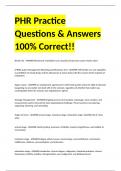PHR Practice
Questions & Answers
100% Correct!!
80/20 rule - ANSWER-80 percent of problems are caused by 20 percent causes. Pareto chart.
LMRDA (Labor Management Reporting and Disclosure Act) - ANSWER-Taft Hartley act, one regulation
is prohibition of closed shops and the allowances of union shops with the consent of the majority of
employees.
Zipper clause - ANSWER-an employment agreement in which both parties waive the right to demand
bargaining on any matter not dealt with in the contract, regardless of whether that matter was
contemplated when the contract was negotiated or signed.
Strategic Management - ANSWER-Ongoing process of innovation, advantage, value creation, and
reassessment used to forecast the next organizational challenge. These functions are planning,
organizing, directing, and controlling.
Stages of stress - ANSWER-arousal stage, resistance stage, exhaustion stage. Identified by dr. Hans
selye.
arousal stage - ANSWER-Teeth grinding, insomnia, irritability, anxiety, forgetfulness, and inability to
concentrate.
resistance stage - ANSWER-Fatigue without cause, mood swings, social withdraws, resentment,
indifference, defiance, procrastination, and indecision.
exhaustion stage - ANSWER-Headaches, chronic fatigue, indigestion, intestinal problems, chronic
depression, hostility, isolation, disorganization, poor judgement, and disillusionment
, The Clayton act - ANSWER-Passed in 1914 to limit the use of injunctions to break strikes and
exempted unions from the Sherman antitrust act.
Sherman Antitrust Act - ANSWER-an 1890 law that banned the formation of trusts and monopolies in
the United States.
HR audit - ANSWER-is a comprehensive method (or means) to review current human resources
policies, procedures, documentation and systems to identify needs for improvement and
enhancement of the HR function as well as to assess compliance with ever-changing rules and
regulations.
The process of attempting to retain the knowledge of workers is known as what? - ANSWER-
Knowledge management
ADDIE model - ANSWER-Analysis
Design
Development
Implementation
Evaluation
Which of the following is the correct sequence of instructional design? - ANSWER-(ADDIE) Analysis,
design, development, implementation, evaluation. The ADDIE model is used to describe the process
of instructional design. It focuses on first identifying the gap between desired and actual behavior,
designing and developing programs to bridge that gap, implementing the training program, and then
evaluating the effectiveness of the training.
pay equity - ANSWER-defined by what the employee brings to the job (inputs) and what they receive
as rewards (outcomes). Degree of secrecy, how wages are set, and the process for determining value
are all elements of organizational justice.
yellow dog contract - ANSWER-an agreement some companies forced workers to take that forbade
them from joining a union. This was a method used to limit the power of unions, thus hampering
their development. Outlawed in 1932 by the Norris-LaGuardia Act.




